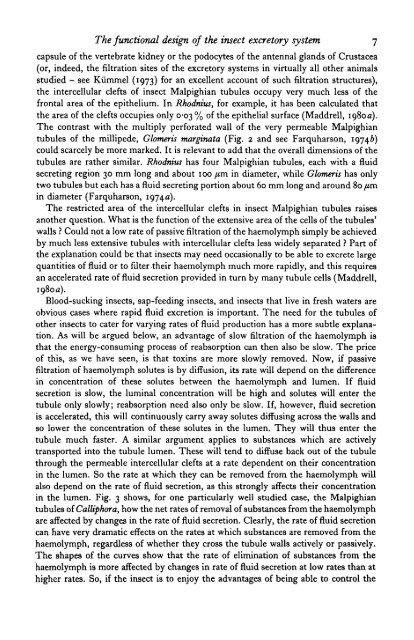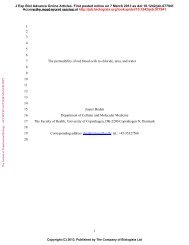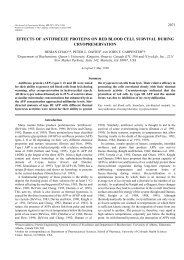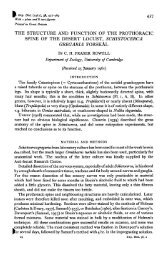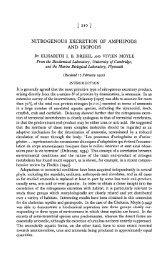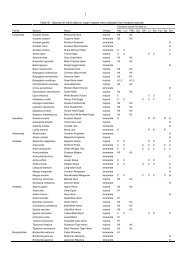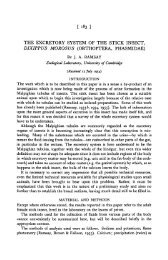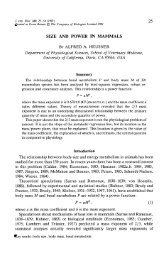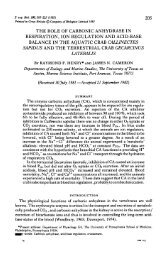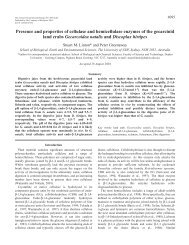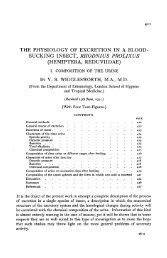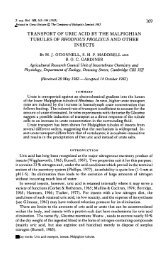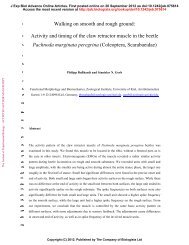the functional design of the insect excretory system - The Journal of ...
the functional design of the insect excretory system - The Journal of ...
the functional design of the insect excretory system - The Journal of ...
You also want an ePaper? Increase the reach of your titles
YUMPU automatically turns print PDFs into web optimized ePapers that Google loves.
<strong>The</strong> <strong>functional</strong> <strong>design</strong> <strong>of</strong> <strong>the</strong> <strong>insect</strong> <strong>excretory</strong> <strong>system</strong> 7<br />
capsule <strong>of</strong> <strong>the</strong> vertebrate kidney or <strong>the</strong> podocytes <strong>of</strong> <strong>the</strong> antennal glands <strong>of</strong> Crustacea<br />
(or, indeed, <strong>the</strong> filtration sites <strong>of</strong> <strong>the</strong> <strong>excretory</strong> <strong>system</strong>s in virtually all o<strong>the</strong>r animals<br />
studied - see Kummel (1973) for an excellent account <strong>of</strong> such filtration structures),<br />
<strong>the</strong> intercellular clefts <strong>of</strong> <strong>insect</strong> Malpighian tubules occupy very much less <strong>of</strong> <strong>the</strong><br />
frontal area <strong>of</strong> <strong>the</strong> epi<strong>the</strong>lium. In Rhodnius, for example, it has been calculated that<br />
<strong>the</strong> area <strong>of</strong> <strong>the</strong> clefts occupies only 0-03 % <strong>of</strong> <strong>the</strong> epi<strong>the</strong>lial surface (Maddrell, 1980a).<br />
<strong>The</strong> contrast with <strong>the</strong> multiply perforated wall <strong>of</strong> <strong>the</strong> very permeable Malpighian<br />
tubules <strong>of</strong> <strong>the</strong> millipede, Glomeris marginata (Fig. 2 and see Farquharson, 19746)<br />
could scarcely be more marked. It is relevant to add that <strong>the</strong> overall dimensions <strong>of</strong> <strong>the</strong><br />
tubules are ra<strong>the</strong>r similar. Rhodnius has four Malpighian tubules, each with a fluid<br />
secreting region 30 mm long and about 100 fim in diameter, while Glomeris has only<br />
two tubules but each has a fluid secreting portion about 60 mm long and around 80 fim.<br />
in diameter (Farquharson, 1974a).<br />
<strong>The</strong> restricted area <strong>of</strong> <strong>the</strong> intercellular clefts in <strong>insect</strong> Malpighian tubules raises<br />
ano<strong>the</strong>r question. What is <strong>the</strong> function <strong>of</strong> <strong>the</strong> extensive area <strong>of</strong> <strong>the</strong> cells <strong>of</strong> <strong>the</strong> tubules'<br />
walls ? Could not a low rate <strong>of</strong> passive filtration <strong>of</strong> <strong>the</strong> haemolymph simply be achieved<br />
by much less extensive tubules with intercellular clefts less widely separated ? Part <strong>of</strong><br />
<strong>the</strong> explanation could be that <strong>insect</strong>s may need occasionally to be able to excrete large<br />
quantities <strong>of</strong> fluid or to filter <strong>the</strong>ir haemolymph much more rapidly, and this requires<br />
an accelerated rate <strong>of</strong> fluid secretion provided in turn by many tubule cells (Maddrell,<br />
1980a).<br />
Blood-sucking <strong>insect</strong>s, sap-feeding <strong>insect</strong>s, and <strong>insect</strong>s that live in fresh waters are<br />
obvious cases where rapid fluid excretion is important. <strong>The</strong> need for <strong>the</strong> tubules <strong>of</strong><br />
o<strong>the</strong>r <strong>insect</strong>s to cater for varying rates <strong>of</strong> fluid production has a more subtle explanation.<br />
As will be argued below, an advantage <strong>of</strong> slow filtration <strong>of</strong> <strong>the</strong> haemolymph is<br />
that <strong>the</strong> energy-consuming process <strong>of</strong> reabsorption can <strong>the</strong>n also be slow. <strong>The</strong> price<br />
<strong>of</strong> this, as we have seen, is that toxins are more slowly removed. Now, if passive<br />
filtration <strong>of</strong> haemolymph solutes is by diffusion, its rate will depend on <strong>the</strong> difference<br />
in concentration <strong>of</strong> <strong>the</strong>se solutes between <strong>the</strong> haemolymph and lumen. If fluid<br />
secretion is slow, <strong>the</strong> luminal concentration will be high and solutes will enter <strong>the</strong><br />
tubule only slowly; reabsorption need also only be slow. If, however, fluid secretion<br />
is accelerated, this will continuously carry away solutes diffusing across <strong>the</strong> walls and<br />
so lower <strong>the</strong> concentration <strong>of</strong> <strong>the</strong>se solutes in <strong>the</strong> lumen. <strong>The</strong>y will thu8 enter <strong>the</strong><br />
tubule much faster. A similar argument applies to substances which are actively<br />
transported into <strong>the</strong> tubule lumen. <strong>The</strong>se will tend to diffuse back out <strong>of</strong> <strong>the</strong> tubule<br />
through <strong>the</strong> permeable intercellular clefts at a rate dependent on <strong>the</strong>ir concentration<br />
in <strong>the</strong> lumen. So <strong>the</strong> rate at which <strong>the</strong>y can be removed from <strong>the</strong> haemolymph will<br />
also depend on <strong>the</strong> rate <strong>of</strong> fluid secretion, as this strongly affects <strong>the</strong>ir concentration<br />
in <strong>the</strong> lumen. Fig. 3 shows, for one particularly well studied case, <strong>the</strong> Malpighian<br />
tubules <strong>of</strong> Calliphora, how <strong>the</strong> net rates <strong>of</strong> removal <strong>of</strong> substances from <strong>the</strong> haemolymph<br />
are affected by changes in <strong>the</strong> rate <strong>of</strong> fluid secretion. Clearly, <strong>the</strong> rate <strong>of</strong> fluid secretion<br />
can have very dramatic effects on <strong>the</strong> rates at which substances are removed from <strong>the</strong><br />
haemolymph, regardless <strong>of</strong> whe<strong>the</strong>r <strong>the</strong>y cross <strong>the</strong> tubule walls actively or passively.<br />
<strong>The</strong> shapes <strong>of</strong> <strong>the</strong> curves show that <strong>the</strong> rate <strong>of</strong> elimination <strong>of</strong> substances from <strong>the</strong><br />
haemolymph is more affected by changes in rate <strong>of</strong> fluid secretion at low rates than at<br />
higher rates. So, if <strong>the</strong> <strong>insect</strong> is to enjoy <strong>the</strong> advantages <strong>of</strong> being able to control <strong>the</strong>


